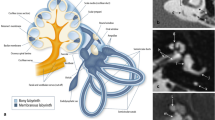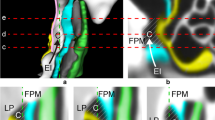Abstract
Purpose
This study is to evaluate the duration of facial nerve enhancement in gadolinium-enhanced temporal bone MRI after the onset of acute facial palsy.
Methods
Gd-enhanced MRI imagines were examined in 13 patients with idiopathic acute facial palsy within 14 days after the onset. The degree of facial nerve function was measured according to the House–Brackmann (H–B) grading system at their first visit at outpatient clinic. The follow-up MRI was taken about 16.5 months (7–24 months) after onset of disease. The degree of facial nerve enhancement was measured with signal intensity (SI) which was quantitatively analyzed using the region-of-interest (ROI) measurements for each segment of the facial nerve. SI was statistically analyzed by comparing SI values of contralateral site and ipsilateral site using the paired t test with SPSS program.
Results
The gadolinium enhancement was statistically increased at labyrinthine segment and geniculate ganglion area of facial nerve at initial temporal bone MRI. The gadolinium enhancement was statistically decreased at all the segments of facial nerve except tympanic segment (p < 0.05) at follow-up MRI.
Conclusions
The facial nerve enhancement in Gd-enhanced MRI images prolonged more than 21 months of the onset. The newly developed pathologic lesions of acute facial palsy especially occur at the site of labyrinthine and geniculate ganglion.



Similar content being viewed by others
Data availability
The data are available from the corresponding author on reasonable request.
References
Adour KK, Byl FM, Hilsinger RL Jr, Kahn ZM, Sheldon MI (1978) The true nature of Bell’s palsy: analysis of 1,000 consecutive patients. Laryngoscope 88:787–801. https://doi.org/10.1002/lary.1978.88.5.787
Kohsyu H, Aoyagi M, Tojima H, Tada Y, Inamura H, Ikarashi T, Koike Y (1994) Facial nerve enhancement in Gd-MRI in patients with Bell’s palsy. Acta Otolaryngol Suppl 511:165–169. https://doi.org/10.3109/00016489409128325
Yetiser S, Kazkayas M, Altinok D, Karadeniz Y (2003) Magnetic resonance imaging of the intratemporal facial nerve in idiopathic peripheral facial palsy. Clin Imaging 27:77–81. https://doi.org/10.1016/s0899-7071(02)00485-0
Anson BJ, Donaldson JA, Warpeha RL, Rensink MJ, Shilling BB (1973) Surgical anatomy of the facial nerve. Arch Otolaryngol 97:201–213. https://doi.org/10.1001/archotol.1973.00780010207026
Balkany T, Fradis M, Jafek BW, Rucker NC (1991) Hemangioma of the facial nerve: role of the geniculate capillary plexus. Skull Base Surg 1:59–63. https://doi.org/10.1055/s-2008-1056981
Balkany T, Fradis M, Jafek BW, Rucker NC (1991) Intrinsic vasculature of the labyrinthine segment of the facial nerve–implications for site of lesion in Bell’s palsy. Otolaryngol Head Neck Surg 104:20–23. https://doi.org/10.1177/019459989110400105
Curtin HD, Jensen JE, Barnes L Jr, May M (1987) “Ossifying” hemangiomas of the temporal bone: evaluation with CT. Radiology 164:831–835. https://doi.org/10.1148/radiology.164.3.3112865
Gebarski SS, Telian SA, Niparko JK (1992) Enhancement along the normal facial nerve in the facial canal: MR imaging and anatomic correlation. Radiology 183:391–394. https://doi.org/10.1148/radiology.183.2.1561339
Schwaber MK, Larson TC 3rd, Zealear DL, Creasy J (1990) Gadolinium-enhanced magnetic resonance imaging in Bell’s palsy. Laryngoscope 100:1264–1269. https://doi.org/10.1288/00005537-199012000-00003
Jonsson L, Tien R, Engström M, Thuomas KA (1995) Gd-DPTA enhanced MRI in Bell’s palsy and herpes zoster oticus: an overview and implications for future studies. Acta Otolaryngol 115:577–584. https://doi.org/10.3109/00016489509139371
Kinoshita T, Ishii K, Okitsu T, Ogawa T, Okudera T (2001) High-intensity facial nerve lesions on T2-weighted images in chronic persistent facial nerve palsy. Neuroradiology 43:388–392. https://doi.org/10.1007/s002340000385
Kinoshita T, Ishii K, Okitsu T, Okudera T, Ogawa T (2001) Facial nerve palsy: evaluation by contrast-enhanced MR imaging. Clin Radiol 56:926–932. https://doi.org/10.1053/crad.2001.0730
Kress B, Griesbeck F, Stippich C, Bähren W, Sartor K (2004) Bell palsy: quantitative analysis of MR imaging data as a method of predicting outcome. Radiology 230:504–509. https://doi.org/10.1148/radiol.2302021353
Kress BP, Griesbeck F, Efinger K, Solbach T, Gottschalk A, Kornhuber AW, Bähren W (2002) Bell’s palsy: what is the prognostic value of measurements of signal intensity increases with contrast enhancement on MRI? Neuroradiology 44:428–433. https://doi.org/10.1007/s00234-001-0738-y
Martin-Duverneuil N, Sola-Martínez MT, Miaux Y, Cognard C, Weil A, Mompoint D, Chiras J (1997) Contrast enhancement of the facial nerve on MRI: normal or pathological? Neuroradiology 39:207–212. https://doi.org/10.1007/s002340050395
Acknowledgements
This study was supported by the Research Fund of the E.N.T. Catholic University of Korea that was created in the program year of 2022.
Author information
Authors and Affiliations
Corresponding author
Ethics declarations
Conflict of interest
The authors declare that there is no conflict of interest.
Additional information
Publisher's Note
Springer Nature remains neutral with regard to jurisdictional claims in published maps and institutional affiliations.
Rights and permissions
Springer Nature or its licensor (e.g. a society or other partner) holds exclusive rights to this article under a publishing agreement with the author(s) or other rightsholder(s); author self-archiving of the accepted manuscript version of this article is solely governed by the terms of such publishing agreement and applicable law.
About this article
Cite this article
Kim, S., Moon, D.H., Jun, BC. et al. The clinical availability of facial nerve enhancement in temporal bone MRI for the patients of idiopathic acute peripheral facial palsy. Eur Arch Otorhinolaryngol 281, 731–735 (2024). https://doi.org/10.1007/s00405-023-08169-5
Received:
Accepted:
Published:
Issue Date:
DOI: https://doi.org/10.1007/s00405-023-08169-5




